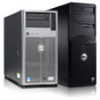Dell PowerEdge XL 5133-4 MXL 10/40GbE Switch IO Module FTOS Command Reference - Page 132
Interface Auto-Configuration, Interface Types
 |
View all Dell PowerEdge XL 5133-4 manuals
Add to My Manuals
Save this manual to your list of manuals |
Page 132 highlights
www.dell.com | support.dell.com Interface Auto-Configuration An Aggregator auto-configures interfaces as follows: • All interfaces operate as layer 2 interfaces at 10GbE in standalone mode. FlexIO module interfaces support only uplink connections. Only the 40GbE ports on the base module can be used for stacking. • By default, the two fixed 40GbE ports on the base module operate in 4x10GbE mode with breakout cables and support up to eight 10GbE uplinks. You can configure the base-module ports as 40GbE links for stacking. • The interfaces on a 40GbE QSFP+ FlexIO module auto-configure to support only 10GbE SFP+ connections using 4x10GbE breakout cables. • All 10GbE uplink interfaces belong to the same 10GbE link aggregation group (LAG). • The tagged VLAN membership of the uplink LAG is automatically configured based on the VLAN configuration of all server-facing ports (ports 1 to 32). The untagged VLAN used for the uplink LAG is always the default VLAN 1. • The tagged VLAN membership of a server-facing LAG is automatically configured based on the server-facing ports that are members of the LAG. The untagged VLAN of a server-facing LAG is auto-configured based on the untagged VLAN to which the lowest numbered server-facing port in the LAG belongs. • All interfaces are auto-configured as members of all (4094) VLANs and untagged VLAN 1. All VLANs are up and can send or receive layer 2 traffic. You can use the CLI or CMC interface to configure only the required VLANs on a port interface. • Aggregator ports are numbered 1 to 56. Ports 1 to 32 are internal server-facing interfaces. Ports 33 to 56 are external ports numbered from the bottom to the top of the Aggregator. For port numbering of Aggregator interfaces in standalone and stacking mode, see Figure 4-2. Interface Types The following interface types are supported on an Aggregator. Interface Type Physical Management Port Channel Default VLAN Supported Modes L2 L3 L2 L2 and L3 Non-default VLANs L2 and L3 (VLANs 2 - 4094) Default Mode 10GbE uplink L3 L2 L2 and L3 (VLAN 1) L2 and L3 Requires Creation No No No No Yes Default State No Shutdown (enabled) No Shutdown (enabled) L2 - No Shutdown (enabled) L2 - No Shutdown (enabled) L3 - No Shutdown (enabled) L2 - No Shutdown (enabled) L3 - No Shutdown (enabled) 118 | Interfaces















